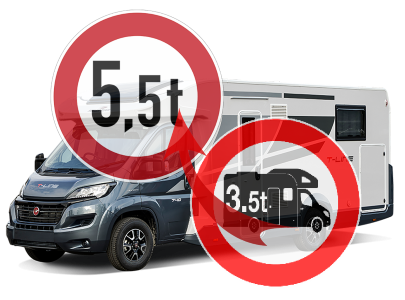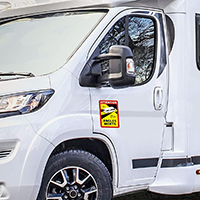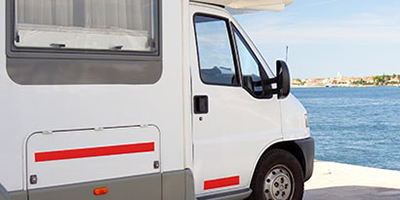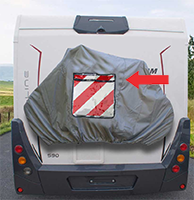
Above 3.5 Tonnes - Is it a beast or a blessing
Whether your upgrading yours or buying, hopefully this will help you decide.
Some of the things you may need to do before getting your 3.5 tonne motorhome reregistered.
- Suspension - this maybe either adding air suspension or stiffer suspension to compensate for the additional weight.
- Engine upgraded - with all this extra weight you will need extra power to get it up those hills - this maybe just having it re-mapped by re-programming the vehicle ECU or you may need to dig deeper adding major components.
- Braking - You may want to consider improved braking. This maybe in the form of a higher quality of pads and shoes, but may need a higher performance disc.
- Possible warranty issues - if this is a relatively new vehicle this could have an impact on your warranty, either motorhome or base vehicle.
- Insurance - this could impact on your insurance policy.
- Many of these upgrades come at a cost, so it's important to consider how important this upgrade is.
- Your licence - in the UK to drive a vehicle above 3.5 tonne requires additional driving licence categories often not given to new drivers.
You may want to consult a qualified engineer to discuss these changes.
Buying above 3.5 tones rather than upgrade.
- Suspension - designed for the additional weight.
- Engine - with all this extra weight it will often have a bigger engine with more BHP.
- Braking – often comes with improved braking or even additional axels.
- Warranty – no issues around the warranty because it has not been modified, either motorhome or base vehicle.
- Insurance – no issues around insurance policy because they know the vehicle.
- Many of these upgrades come at a cost, you may find that the additional cost to buy your bigger vehicle may work out more cost efficient.
- Often these are longer with bigger habitation areas
- Handling – because they designed from ground up, they do not handle unpredictable.
- Your licence - in the UK to drive a vehicle above 3.5 tonne requires additional driving licence categories often not given to new drivers.
You may want to consider this as an option.
Upgrading your motorhome to above the 3.5-tonne category in terms of vehicle weight comes with its own set of advantages and disadvantages. Here are some pros and cons around this upgrade:
Pros:
The most obvious advantage of upgrading your motorhome to above 3.5 Tonnes would be its additional ability to take that extra load.
- Used for extra storage.
- Additional water supplies
- Additional gas supplies
- Additional passengers
- Extra towing capacity
Private HGV - (TC10)
A motorhome or campervan with a revenue weight above 3500kg is categorised as a private heavy goods vehicle. However, these private heavy goods vehicles are taxed based on weight, emissions, and the number of axles.
- A motorhome or campervan with a revenue weight between 3500-7500kg is taxed £165 per annum.
- Campers that weigh 7,500-11,999kg have an annual road tax cost of £200.
- Motorhome tax rates increase for vehicles with revenue weight of 12,000kg and above. However, the tax is based on CO2 emissions, and vehicles that weigh 12,000kg to 14,000kg with a Euro VI-compliant engine will have a road tax rate of £189.50 per year.
- Motorhomes with the same weight but Euro V-compliant will be charged £221 per annum.
Prices TBC on latest rates - Updated on April, 2024
The added weight of your motorhome will enhance its capacity to tow a heavier vehicle, adhering to the general rule that the towed vehicle should be approximately 85% of the weight of the towing vehicle.
However, it's essential to consider the structural capacity of the tow bar and mounting for any additional limitations.
Increasing the gross weight of a motorhome can improve stability, especially in windy conditions or when driving on uneven terrain. The additional weight can help to counteract sway and improve overall handling.
However, this will only be the case when all other modifications have been done to meet with the increased weight i.e. suspension, tyres braking weight distribution etc.
Cons:
In the UK, driving a motorhome over 3500kg requires specific licensing and may entail additional requirements.
Category C1 Driving License:
To drive a motorhome over 3500kg but not exceeding 7500kg (with a trailer of up to 750kg), you generally need a category C1 driving license. This license allows you to drive vehicles weighing between 3500kg and 7500kg.
Driver Training and Testing:
If you don't already hold a category C1 driving license, you'll need to undergo specialized training and pass a test to obtain it. This typically involves completing a theory test and practical examination focusing on driving skills, vehicle handling, and safety procedures specific to larger vehicles.
Motorhomes over 3500kg must be properly registered with the DVLA (Driver and Vehicle Licensing Agency). This ensures that the vehicle meets safety and regulatory standards for its weight class.
Insurance coverage for motorhomes over 3500kg may differ from standard vehicle insurance. Insurers may consider factors such as the vehicle's weight, size, and intended use when determining coverage and premiums.
Also because these modifications are outside of the standard build they may be increased insurance rates added
In the UK, driving a motorhome over 3500kg may entail certain road restrictions due to the vehicle's size and weight.
- Weight Limits: Some roads, bridges, and tunnels have weight restrictions to ensure the safety of infrastructure and other road users. Vehicles exceeding a certain weight threshold may be prohibited from accessing these routes
- Low Bridges and Tunnels: Motorhomes over 3500kg may encounter weight restrictions when passing over bridges. It's essential to check weight limits before attempting to navigate these structures to avoid causing damage.
- Traffic Signs: Pay attention to traffic signs indicating weight limits
- Planning Routes: When planning your journey, consider the additional weight of your motorhome and choose routes that are suitable for larger vehicles. Use GPS navigation systems or maps specifically designed for motorhomes to avoid restricted areas and navigate safely.
When driving a motorhome over 3500kg on EUroads, it's essential to be aware of specific regulations and considerations.
- Speed Limits: The speed limits for motorhomes over 3500kg in the EU are generally lower than those for lighter vehicles. On highways (autoroutes), the speed limit for motorhomes weighing over 3500kg is 110 km/h, whereas it's 130 km/h for vehicles under 3500kg.
- Road Tolls: When driving on EU highways, you'll encounter toll booths. Motorhomes over 3500kg are classified as category 2 vehicles and are subject to higher toll charges than lighter vehicles. Be prepared to pay tolls based on your vehicle's weight and height.
- Environmental Zones: Some cities in EU, such as Paris and Lyon, have low-emission zones (Zones à Circulation Restreinte, ZCR) where access is restricted to vehicles meeting certain emission standards. Heavier motorhomes may be subject to additional restrictions or charges in these zones
- Parking and Overnight Stops: When parking or staying overnight in EU with a motorhome over 3500kg, look for designated motorhome parking areas (aires de services) or campsites that can accommodate larger vehicles. Many campsites offer facilities such as electrical hook-ups and waste disposal suitable for heavy motorhomes.
- Documentation: Ensure you have all necessary documentation for your motorhome, including vehicle registration, insurance papers, and proof of ownership. Carry your driving license and passport with you at all times when driving in the EU.
Selling a motorhome weighing over 3500 kg can pose challenges due to the smaller pool of drivers holding the necessary C1 classifications, especially among younger demographics. This limitation narrows the potential buyer base, potentially complicating future sales and potentially lowering the selling price.
Ultimately, the decision to upgrade your motorhome to over 3500kg depends on your specific needs, preferences, and budget. If you prioritize s payload and are willing to deal with the associated costs and requirements, a heavy motorhome could be the right choice for you.
Purchasing above the 3.5-tonne category in terms of vehicle weight and size comes with its own set of advantages and disadvantages. Here are some pros and cons around taking the hassle free approach:
Pros:
Generally, heavier motorhomes offer more space for living, sleeping, and storage. This extra space can make long trips or full-time living more comfortable.
Heavy motorhomes often come with more luxurious amenities such as larger bathrooms, kitchen appliances, entertainment systems, and more.
With a higher weight rating, you have the capacity to carry more gear, equipment, and supplies without worrying about exceeding weight limits.
The additional weight can provide better stability and smoother rides, especially in windy conditions or when passing large vehicles.
Heavy motorhomes tend to be built on stronger chassis to support the weight, which can translate to increased durability and longevity.
Cons:
Heavy motorhomes typically come with a higher price tag both upfront and in terms of ongoing maintenance and fuel costs.
In many regions, driving a motorhome over a certain weight requires a special license or additional endorsements, which can be a hassle to obtain.
Due to their weight, heavy motorhomes tend to have poorer fuel efficiency compared to lighter models, resulting in higher fuel costs.
Heavy motorhomes can be more challenging to maneuver and park, especially in tight spaces or congested urban areas.
Some roads, bridges, and tunnels have weight restrictions, which may limit where you can travel with a heavy motorhome.
Maintenance costs can be higher for heavy motorhomes due to the wear and tear associated with their weight, as well as the complexity of systems.
Selling a motorhome weighing over 3500 kg can pose challenges due to the smaller pool of drivers holding the necessary C1 classifications, especially among younger demographics. This limitation narrows the potential buyer base, potentially complicating future sales and potentially lowering the selling price.
Ultimately, the decision to purchase a motorhome over 3500kg depends on your specific needs, preferences, and budget. If you prioritize space, amenities, and payload capacity and are willing to deal with the associated costs and requirements, a heavy motorhome could be the right choice for you.
Road Tax
In the UK, the road tax for motorhomes is based on the vehicle's weight, emissions, and fuel type, among other factors. As of my last update, there isn't a blanket rule stating that road tax is necessarily less for motorhomes above 3500kg compared to those below this weight. However, there are some considerations:
-
Vehicle Excise Duty (VED) Rates: VED rates for motorhomes are calculated based on their CO2 emissions and weight. Generally, vehicles with lower emissions and/or lower weight attract lower road tax rates. However, motorhomes are often taxed at a flat rate rather than being based solely on emissions.
-
Alternative Fuel Discount: Some motorhomes that use alternative fuels such as electricity or hybrids may qualify for a discount on road tax.
-
Historic Vehicle Status: Motorhomes over a certain age (typically 40 years old or more) may qualify for Historic Vehicle status, which exempts them from road tax.
-
First Year Rate: For new motorhomes, there may be a first-year rate based on CO2 emissions. This rate could vary depending on the weight and emissions of the vehicle.
-
Weight-based Charges: There might be additional charges or fees for vehicles over certain weight thresholds, but these are often related to things like congestion charges in certain cities rather than the standard road tax.
It's essential to check the current regulations and tax rates with the Driver and Vehicle Licensing Agency (DVLA) or relevant authorities in the UK as these can change over time. Additionally, tax rules may vary for motorhomes used for personal versus commercial purposes.
Ferry or Tunnel Crossings
Ferry charges for motorhomes can vary based on several factors, including size, weight, length, height, and sometimes even the number of axles. While there isn't a universal rule that ferries charge less for motorhomes under 3500kg compared to slightly heavier ones, there are some considerations that may affect ferry pricing:
-
Size and Space: Ferries often charge based on the amount of space a vehicle occupies on the deck. Larger motorhomes, regardless of weight, may be charged more because they take up more space.
-
Weight-Based Charges: Some ferry operators do have weight-based pricing tiers. Motorhomes over certain weight thresholds might fall into a higher pricing category.
-
Length and Height: Motorhomes that are longer or taller may be subject to additional charges due to the space they occupy and any special accommodations required.
-
Special Vehicles: Some ferry operators may have specific pricing for oversized or heavy vehicles, which could apply to motorhomes above a certain weight regardless of whether they are under or over 3500kg.
-
Destination and Route: Ferry charges can also vary depending on the route, destination, time of year, and any additional services or amenities provided during the voyage.
It's essential to check with the ferry operator directly or consult their website for specific pricing details, as policies can vary between operators and even between different routes offered by the same operator.
What Stickers?
For a motorhome weighing over 3500 kg in the EU, including "angles morts" (French for "blind spots"), there are specific requirements to enhance safety, visibility, and compliance with regulations. Here's a list of stickers and markings commonly needed:
-
Maximum Allowable Mass (MAM) Plate: As mentioned earlier, this plate indicates the maximum weight the motorhome can legally carry.
Speed Limit Sign:
-
Some countries require motorhomes over a certain weight to display a speed limit sign indicating the maximum speed allowed for that vehicle.
Blind Spot Warning Stickers:
-
These stickers are placed on the motorhome to alert other road users about the vehicle's blind spots. They usually depict a warning symbol and may include text such as "Attention: Angles Morts" to indicate blind spots.

Reflective Markings:
-
Reflective tapes or markings on the sides and rear of the motorhome increase visibility, especially in low-light conditions. These markings help other drivers see the vehicle more clearly, reducing the risk of accidents.

Warning Signs for Overhanging Loads:
-
If the motorhome has overhanging loads, such as bicycles or cargo carriers, warning signs indicating the protruding length are necessary for safety and compliance.

Towing Limitations (if applicable):
-
If the motorhome is equipped for towing, there may be stickers or signs indicating the maximum allowable towing capacity and any relevant limitations.
Emergency Exits and Safety Equipment Markings:
-
If the motorhome has emergency exits or safety equipment such as fire extinguishers, emergency hammers, or first aid kits, appropriate markings indicating their location may be required.
Country-Specific Requirements:
-
Depending on the country within the EU, there may be additional stickers or markings required for compliance with local regulations. It's essential to research the specific requirements of each country you plan to travel through.
By adhering to these requirements and ensuring that the motorhome is properly marked and equipped, you can enhance safety for yourself and other road users while complying with EU regulations.
Inconclusion
Hopefully this article will have helped with some pros and cons around either buying a preconfigured Motorhome with the additional capacity or to upgrade your previous 3500kg unit. Ultimately the choice is yours based on budget, space, and needs. What is important is that you have a wonderful time with your purchase making great memories.

